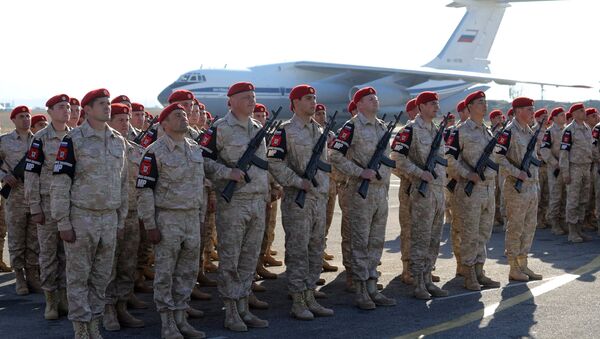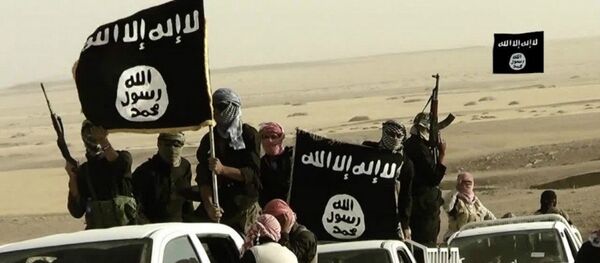Shoigu explained how the situation faced by the country's Armed Forces in the beginning of the 2010s was improved. He also reported how many weapons the Russian army had tested in Syria, and how the missile capabilities of the Russian Armed Forces have increased. Shoigu’s speech focused on Russia’s defense readiness and related legal issues. The figures that Shoigu mentioned were related to the period after 2012, after he came to head the Russian Defense Ministry.
Syrian Experience
All military units of the Russian Armed Forces are now combat-ready, Shoigu said. He recalled that this was not always the case.
"In 2012, the composition of the stand-by forces included only 16 formations. Brigades were formed instead of divisions and were staffed 50-75 percent. The timing for bringing them to combat readiness in one hour was not reached", the head of the military department said.
READ MORE: Russia, Syria Accuse US of 'Colonial Mentality' Over Situation in Rukban Camp
Shoigu highlighted the opportunity for the Russian army to participate in operations in remote regions of the world.
According to Shoigu, as a result of the disbandment of the Main Directorate of Combat Training at that time, the unified leadership of the combat training process was lost. Since 2015, Russian troops have been taking part in operations against terrorist groups in Syria.
"In total, we have tested 316 types of modern weapons in Syria", the minister said.
New Missile
The Russian Armed Forces received 109 intercontinental ballistic missiles, as well as 108 submarine-launched ballistic missiles in 2012-2018, Shoigu said.
"Over six years [2012-2018], the Armed Forces received 109 intercontinental Yars ballistic missiles; 108 submarine-launched ballistic missiles; three Borei strategic submarine missile cruisers; 57 spacecraft; seven submarines… 3,712 new and upgraded tanks and other armored combat vehicles; more than 1,000 planes and helicopters; 161 surface ships", Shoigu said.
READ MORE: Analysts Explain How Trump's Pull-Out From Syria Affects Turkey, Israel & Russia
The minister noted that these supplies had allowed to rearm 12 missile regiments with Yars systems, 10 missile brigades with Iskander systems, 13 aviation regiments with MiG-31BM, Su-35S, Su-30SM, and Su-34 fighters, three army aviation brigades and six helicopter regiments with Ka-52 and Mi-28 helicopters. Twenty anti-aircraft missile regiments were rearmed with S-400 anti-aircraft missile system, 23 divisions with Pantsir-S complex, 17 divisions with Bal and Bastion missile systems.
Shoigu said that Russia had increased the number of its high-precision cruise missiles 30-fold over the six years, and the number of their carriers had increased more than 12-fold. According to the information provided by the minister, in 2012 there had practically been no long-range precision weapons in the Armed Forces.
READ MORE: Russian Military Reveals How US Could Intercept New Sarmat Missile
According to the minister, three units of unmanned aircraft in the Armed Forces were equipped with 91 outdated systems with unmanned aerial vehicles from the 1970s. "Their characteristics did not allow them to perform tasks in modern combat", he stated.
Armed Drones
The Russian army has received new opportunities for exploration and destruction of enemy targets with the help of drones, in the development of which a "qualitative leap forward" was made, Shoigu said.
"So, thanks to the laser illumination from the drones, it was possible to give a second life to the previously unclaimed high-precision explosive artillery shells Krasnopol. As a result, their consumption decreased – no more than two shells per one target, and the range of the use increased", the minister added.
The Russian army in 2019 will for the first time receive reconnaissance-shock drones, Shoigu said.
READ MORE: Russia to Commission 2nd Fifth-Generation Su-57 Fighter in 2020 — Manufacturer
The minister noted that over the six years, 38 military units had been formed, which were armed with more than 2,000 modern unmanned aerial vehicles.
Less Failures
Shoigu also told how the army had managed to significantly reduce the number of weapon failures over six years. "Military representative offices have been revived in their modern form. Thus, the quality control of products by defense companies has been strengthened. The number of failures of new weapons and equipment has been reduced 2.7 times", the minister said.
WATCH: Russian Defence Ministry Posts First VIDEO of 5th-Gen Su-57 Jet Flying in Syria
He recalled that by the beginning of the 2010s, the staff of military representative offices had been greatly reduced, with their functions being partially transferred of the producers' own departments. However, their number began to increase again in 2013. In addition, Shoigu criticized the army's previous outsourcing system.
"In fact, outsourcing developed only where it brought a good income and there were no obligations", he added. Today, the situation has changed dramatically, Shoigu noted.
"The repair shops restored at the arsenals in the current year alone brought back to operation 550,000 missiles and ammunition units. Their purchase would have cost the budget 63 billion rubles", the minister noted.
Growth of Army Confidence
Since 2012, the number of Russians negatively assessing the activities of the Russian Armed Forces has decreased to 7 percent from 31 percent, Shoigu said.
"Opinion polls conducted over the past 2-3 years show that about 90 percent of the country's population trusts the Russian army", he said.
READ MORE: Russia Developing New Advanced Gun System for Armata-Based Tanks – MoD
The changing attitude also affected the growth in the number of contract servicemen in the Armed Forces. Since 2012, their number more than doubled almost to 400,000. According to Shoigu, now in each regiment and brigade, two battalions are staffed with contract servicemen, and the third with conscripts.
"At the same time, conscripts are not involved in the performance of combat missions", the general explained. A total of 136 battalion tactical groups in the Russian army are staffed by contract soldiers exclusively, Shoigu noted.




